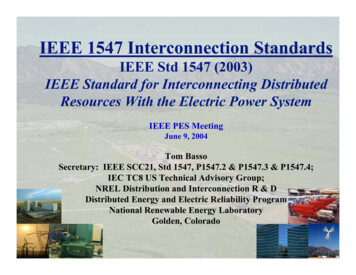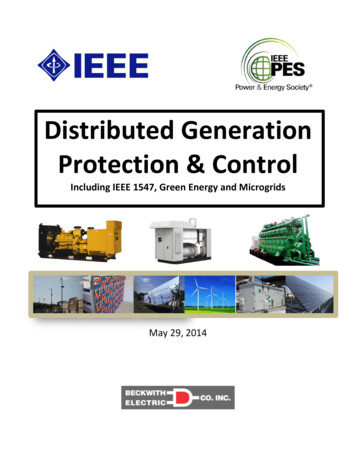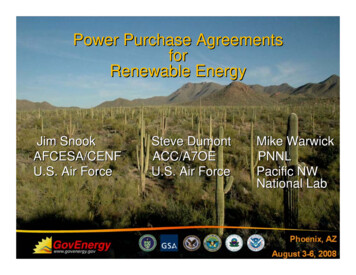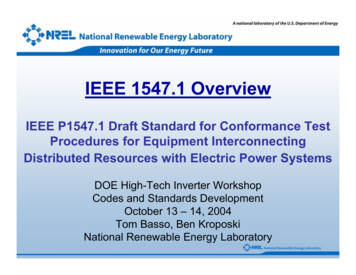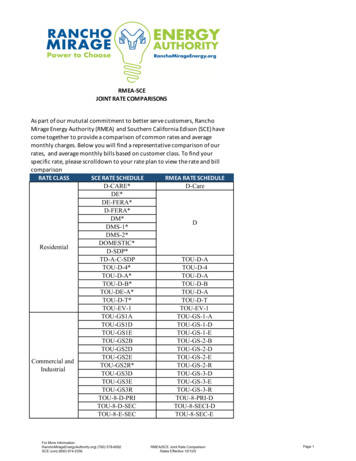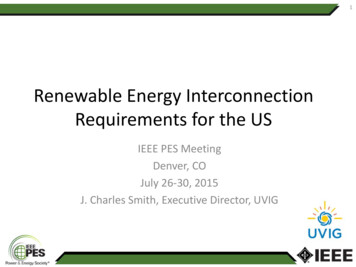
Transcription
1Renewable Energy InterconnectionRequirements for the USIEEE PES MeetingDenver, COJuly 26-30, 2015J. Charles Smith, Executive Director, UVIG
2Outline of Topics Background and Introduction NERC Integrating Variable Generation TaskForce (IVGTF) Interconnection Tasks– Interconnection Requirements– Reconciliation of FERC Order 661A with IEEE 1547– BA Communication Requirements Conclusions
3North American Interconnections
4NERC IVGTF Report Background Broad based industry effort with participation of utilities,ISOs, turbine manufacturers, project developers, researchorganizations, consultants, trade associations Requested by OC/PC in recognition of the increasing large rolewind power will play Chaired by Warren Frost, AESO with NERC staff supportprovided by Mark Lauby and John Moura Initial report released in April 2009 Final Phase 2 task report completed in 2014
5Guiding Principles –Keeping Reliability in the Balance Bulk power system reliability must bemaintained, regardless of the generation mix All generators must contribute to systemreliability within their physical capabilities Industry standards and criteria must be fair,transparent and performance-based
6Interconnection Recommendationsfrom NERC IVGTF Report Task 1.3: Interconnection procedures and standards(i.e. grid codes) should be enhanced and must beapplied in a consistent manner to all generationtechnologies to address: real and reactive power control frequency and inertial response voltage and frequency ride through Task 1.7: Existing bulk system voltage ride-throughperformance requirements (FERC Order 661-A) anddistribution system anti-islanding voltage drop-outrequirements of IEEE Standard 1547 must be reconciled
7Interconnection Task Recommendationsfrom IVGTF Report Task 2.2: Balancing Areas must have sufficientcommunications for monitoring and sending dispatchsignals to variable resources
8Task 1.3 Objective Interconnection procedures and standardsshould be enhanced to address:– real and reactive power modeling and control– frequency and inertial response– voltage and frequency ride-through Must be applied in a consistent manner to allgeneration technologies
9Interconnection Topics Reactive Power and Voltage ControlPerformance During and After DisturbancesActive Power ControlHarmonics and Subsynchronous InteractionModels for Facility Interconnection StudiesCommunications between VariableGeneration Plants and Grid Operators
10Reactive Power and Voltage Control Applicability: Generator interconnection requirement forreactive power should be clearly established for all generatortechnologies Specification of Reactive Range Should be defined over the full output range Q vs. P chart should be used for clarity Baseline capability of /- 0.95 lead/lag at full output andnominal voltage should be considered Specification of Dynamic Reactive Capability Should clearly define what is meant by “Dynamic” ReactiveCapability
11Performance During and afterDisturbancesApplicable plant size– Scope of existing NERC standard should bebroadened to cover smaller plant sizes. Thecurrent proposal of 75 MVA is too large.– Size of 10-20 MW more appropriate
12Performance During and afterDisturbancesDisturbance ride-through– Additional clarity should be provided for existing fault ridethrough and frequency ride-through standards– Ride-through plots should be provided for both high andlow voltage ride-through requirements. It is recommendedthat the zero voltage ride through should be equal to thethree phase fault clearing time on the network.– Performance requirements for balanced and unbalancedfaults should be clearly defined.– Restart expectations of generator following a disturbanceshould be clarified
13Active Power Control Require curtailment capability, but avoidrequirements for excessively fast response Require capability to limit rate of increase ofpower output Encourage or mandate reduction of active powerin response to high frequencies Consider requiring the capability to provideincrease of active power for low frequencies Consider requiring inertial response in nearfuture
14Turbine Technology AdvancesReduce Impacts
15Harmonics and SubsynchronousInteraction No need for NERC standard at this time However, it would be prudent for transmissionowners and/or grid operators to:--Request design study reports that assess theharmonic performance of all wind and solarplantsRequest design study reports that assess the risk,and if necessary mitigation, of wind and solarplant located near series compensatedtransmission lines
16Models for Facility InterconnectionStudies Preliminary model data may be used for the initialfeasibility study of a VG interconnection project The best available model should be used for the finalSystem Impact Study or Facilities Study.– Models can be user written and may require nondisclosure agreements. Detailed dynamic model– Must be accurate over the range of 0.1 to 5 Hz– Time constants in the model should not be 5 ms– The detailed dynamics model must have beenvalidated against a physical or type test
17Communications Between VG Plantand Grid Operator Recommendations based on existing policy forconventional generators VG plants should send a minimum set of monitoring data tothe grid operation via the grid’s SCADA network VG plants should receive and execute command signals(power limit, voltage schedule, ramp rate limit, etc.) sentfrom the grid operator via the SCADA network VG plants should have trained on-call plant operators thatcan receive calls from the grid operator 24/7 andimmediately execute verbal commands. The plantoperators would not need to be located at the plantprovided they have secure remote control capability for theplant.
18Task 1.7 Objective Existing bulk power system low voltage ridethrough requirements of FERC Order 661Aand distribution system anti-islanding voltagedrop-out requirements of IEEE Standard 1547must be reconciled.
19Interconnection Standards andRequirements for ‘Variable’ Generation
20Interconnection - Task 1.7Reconciliation of Order 661-A and IEEE 1547Recommendations– In the short-term, NERC should engage in current efforts torevise IEEE Standard 1547 for DER interconnection by providinginformation, raising awareness and encouraging the adoption ofVRT and FRT for DERs– In the longer-term, NERC should establish a coordinationmechanism with IEEE Standard 1547 to ensure that BPSreliability needs are factored into future DER interconnectionstandards revision efforts– Recognizing that BES connected VERs are under FERCjurisdiction, and distribution system connected VERs in mostcases are under the state utility commission jurisdictions, withtheir performance requirements in most cases dictated by IEEEStandard 1547, a closely coordinated and cooperative effortbetween NERC and IEEE is proposed in this area
21Interconnection - Task 1.7Reconciliation of Order 661-A and IEEE 1547Summary of Conclusions– Recommended ride-thru and must trip requirements for DER
22Task 2.2 Objective To ensure that Balancing Areas have sufficientcommunications for monitoring and sendingdispatch instructions to variable resources
23Task 2.2 Draft Recommendations –Data and Communications Data and communication capabilities which have an impacton the reliability of the BES should be provided by allgeneration operating in the BA Because several smaller wind farms, regardless of theinterconnection to the transmission system or thedistribution system, can in aggregate have a significantimpact on a specific area of the BES, a subset of thisinformation should be provided by all generators greaterthan 10 MW Additional planning and meteorological data should also berequired for all generators 10 MW or greater within a BAregardless of interconnection point, if a significant impacthas been identified in an interconnection study
24Wind and Solar Plants are PowerPlants Dispatchable– Easy if done right, high errors if “fuel characteristics” are ignored Ride through disturbances– Wind ride-through requirements exceed those of conventional generatorsper FERC Order 661A and exceed NERC Standard PRC-024 requirements Provide fast frequency response and voltage control– Implemented for wind in ERCOT and other regions Impressive ramping and active power control– Very fast and accurate response over entire capability range
25Interconnection Requirements Strong grid code is in the best interest of both themanufacturer/developer and the utility– Wind and solar power plants are very capable machines– Plants must support system reliability requirements Grid code should identify the following requirements––––––Real power controlReactive power and voltage controlFrequency and inertial responseVoltage and frequency ride throughDetailed dynamic models for facility interconnection studyCommunications between power plant and grid operator
26General Recommendations Require all new power plants to have the capability of providingessential reliability services i.e. voltage regulators and governors– All plants should be capable of contributing to system reliability– Operational use of plants to provide services will vary based oneconomics (need for service, value of service, opportunity cost)– Not every plant needs to provide every reliability service at alltimes, but we can’t perfectly predict future needs or values– All power plants should ride through disturbances We will learn and adapt as the generation mix and loadcharacteristics change
27Time of Transition Work of the IVGTF is being wrapped up Numerous recommendations from the IVGTF arebeing referred to NERC standards review anddevelopment process NERC Essential Reliability Services Task Force(ERSTF) has continued some of the work begunby the IVGTF This will continue to be an important topic forsome time to come Complex topic due to technical, economic,market and policy dimensions
28PJM Stakeholder ApprovedRequirements
29For More Information Visit www.uvig.org Email info@uvig.org Phone– Charlie Smith 252-715-0796– Sandy Smith 865-218-4600 x6141 MailUtility Variable-Generation Integration GroupPO Box 2787Reston, VA 20195 USA
Reconciliation of Order 661-A and IEEE 1547 Recommendations –In the short-term, NERC should engage in current efforts to revise IEEE Standard 1547 for DER interconnection by providing information, raising awareness and encouraging the adoption of VRT and FRT for DERs
